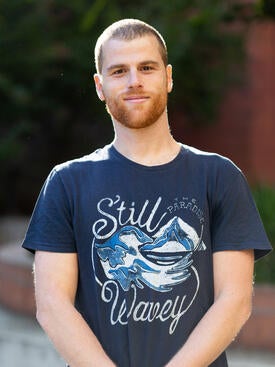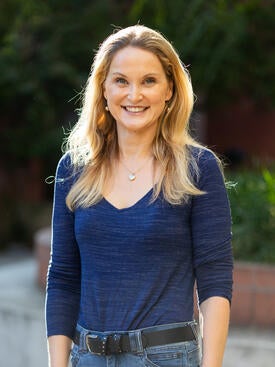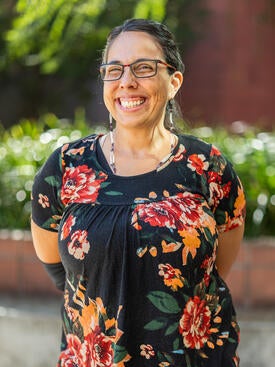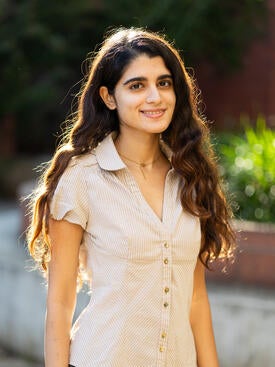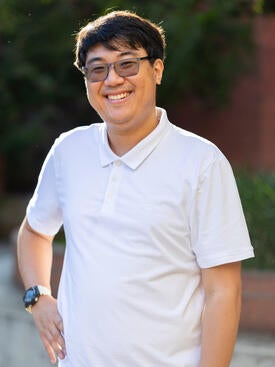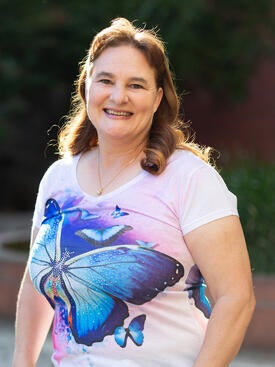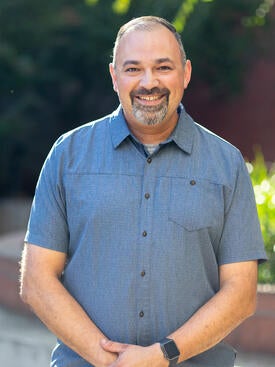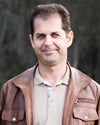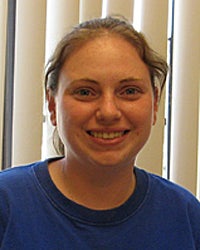Hoddle Lab Members
Mark S. Hoddle, Ph.D.
Biological Control Specialist and Principal Investigator
Dr. Hoddle has headed the research in this laboratory since 1997 and is primarily involved in the identification of pest problems wf biological control could be a successful approach. The location, release and evaluation of natural enemy impacts on population growth features strongly in his research. The evaluation of biological control agents are conducted primarily in the field and, when necessary, aspects of both pest and natural enemy biology and behavior are studied in the laboratory.
Nicola A. Irvin, Ph.D.
Biological Control Specialist and Research Scholar
Dr. Irvin joined the Hoddle laboratory in 2001 as a post doctoral scholar. Dr Irvin has had a heavy focus on researching the glassy-winged sharpshooter, Homalodisca vitripennis (Germar), and its Mymarid wasp biological control agentsGonatocerus ashmeadi, G. fasciatus, G. triguttatus, and G. tuberculifemur. Currently, Dr. Irvin is collaborating with Dr. Milosavljević on research investigating whether insectary plants (used to augment populations of natural enemies) and biodegradable hydrogel bead baits (for control of Argentine ants) can enhance natural enemy abundance and increase biological control of citrus pests.
Marco Molfini, Ph.D.
Postdoctoral Scholar
Dr. Molfini joined the Hoddle lab as a postdoctoral researcher in September 2023. In his previous research, he explored the phylogeny and ecology of cantharphilous species: a group of arthropods attracted to the toxic compound cantharidin. He is currently working on the proactive biological control of the spotted lanternfly (Lycorma delicatula), with the aim of identifying native US parasitoids to use as control agents. He is also studying the host range of L. delicatula on the most common California crop plants.
Mari West
Dr. West joined the Hoddle Lab as a postdoctoral researcher in November 2022. Her previous research focused on task allocation behaviors in ants and their morphological, chemical, and genetic underpinnings. In the Hoddle Lab, Dr. West is working on the proactive biological control of the Spotted Lanternfly, an invasive plant pest. Her work includes identifying US native parasitoid wasps that have the potential to control the Spotted Lanternfly, as well as determining which of California’s crops are susceptible to Spotted Lanternfly feeding and damage.
Joeleen Tamm
Paloma Dadlani
Soon Kwon
Hoddle Lab Staff
Ruth Amrich
Lab Assistant IV
Phone: 951-827-4360
ruth.amrich@ucr.edu
Ruth attained her degree in Biology from California State University, San Bernardino in 1996. There she worked with Dr. Alexander Sokoloff with genetically mutated Tribolium species as a lab assistant maintaining colonies. She joined the Hoddle lab in 2001.
Through the years, Ruth has been involved in multiple projects with Dr. Hoddle: Avocado thrips Scirtothrips perseae (Thysanoptera: Thripidae) and its biocontrol agent Franklinothrips orizabensis Johansen (Thysanoptera: Aeolothripidae); the persea mite Oligonychus perseae Tuttle, Baker and Abatiello (Acari: Tetranychidae); Levuana iridescens Bethune-Baker (Lepidoptera: Zygaenidae); interbreeding capabilities between different populations of the bean thrips Caliothrips fasciatus (Pergande) and the effects of cold storage on its survival and reproduction; the monitoring program for Rhychophorus ferrungineus (Olivier) (Coleopetera: Curculionidae) incursion of Southern California. Read more...
Mike Lewis
Lab Assistant IV
Phone: 951-827-4360
michael.lewis@ucr.edu
Mike started with the Hoddle lab 2004, and helps with a number of support roles within the lab. In addition to managing the lab computer and tech network for the lab, he also serves as the Website Administrator for the Center for Invasive Species Research (CISR). He also contributes blog posts and photographs of the invasive species listed on the CISR site, as well as other related graphic materials, videos, still photographs and aerial drone media.
Mike provides support for many of the research projects within the Hoddle lab. Some of the research Mike has been involved in includes Brown Marmorated Stink Bug (Halyomorpha halys), glassy-winged sharpshooter (Homalodisca vitripennis), gold spotted oak borer (Agrilus auroguttatus), avocado thrips (Scirtothrips perseae), mealybugs (Pseudococcidae), Gonatocerus ashmeadi, persea mites (Oligonychus perseae), asian citrus psyllid, (Diaphorina citri), Diaphorencyrtus aligarhensis (Hymenoptera: Encyrtidae), tamarixia radiata, south american palm weevil, (Rhynchophorus palmarum), and argentine ants (Linepithema humile).
A gallery of some of Mike’s photography with the Center for Invasive Species can be found here
Past Researchers
Meghan Vankosky, Ph.D.
Dr. Vankosky is working on establishing a release and monitoring program for the parasitoid Diaphorencyrtus aligarhensis (Shafee, Alam and Agrawal) (Hymenoptera: Encrytidae) in southern California, with the goal of determining its ability to establish populations and contribute to the mortality of the Asian citrus psyllid. She also intends to evaluate the competitive relationship between D. aligarhensis and Tamarixia radiata (Waterston) (Hymenoptera: Eulophidae) and using a series of laboratory and microcosm experiments.
Erica Kistner, Ph.D.
Dr. Kistner joined the Hoddle laboratory as a Postdoctoral Scholar in July 2014. She evaluated the ongoing biological control efforts concerning the Asian Citrus Psyllid (ACP), Diaphorina citri Kuwayama (Hemiptera: Psyllidae) in CA. Her research examined the population dynamics of D. citri in southern CA. By conducting manipulative studies in the field. The goal was to evaluate the efficacy of the biocontrol agent, Tamarixia radiata (Waterston) (Hymenoptera: Eulophidae), in regulating D. citri populations
Allison Bistline-East, M.S.
Allison entered the PhD program in Entomology in 2013, but her ties to the Hoddle lab stretch back much farther. While an undergraduate, she worked in Dr. Paul de Ley's lab (UCR Department of Nematology) researching marine and freshwater nematode ecology. After receiving her bachelor's degree in 2008, she left the De Ley lab and was hired by the Hoddle lab to assist on glassy-winged sharpshooter (GWSS) research being conducted in organic vineyards. After the GWSS project came to an end, Allison was transferred to a new project focusing on the Asian citrus psyllid (ACP),Diaphorena citri. She has been working with ACP and its associated natural enemies from Pakistan (Tamarixia radiata (Hymenoptera: Eulophidae) and Diaphorencyrtus aligarhensis (Hymneoptera: Encyrtidae)) for the past 3 years, and is continuing this research as she pursues her PhD.
Vanessa Lopez, Ph.D.
Vanessa Lopez was a Ph.D. candidate in the Entomology Department who joined the Hoddle lab in September 2009. She worked on developing a classical biological control program for the invasive goldspotted oak borer, Agrilus auroguttatus, (GSOB) which included identifying the native range of GSOB and surveying for co-evolved natural enemies of this pest. Vanessa also conducted research on the biology and life history of GSOB to understand important traits such as fecundity, longevity, and dispersal potential. While an undergraduate at the University of California, Riverside (UCR), Vanessa studied overseas via the University of California’s Education Abroad Program. Through this program, she had the opportunity to study tropical conservation and biology in Monteverde, Costa Rica. The Tropical Conservation and Biology program focused strongly on research, and throughout the quarter she participated in several group and individual research projects. These projects encompassed many facets of biology such as behavior, diversity, and ecology. Examples of these research projects include examining species composition at different levels within an intertidal zone, and studying insect diversity in pasture, primary, and secondary forests. Vanessa's individual study project in Costa Rica examined hitchhiking behavior and load selection in the leaf-cutter ant, Atta cephalotes. In leaf-cutter ants, small workers often ride or “hitchhike” on leaf fragments carried back to the nest by larger foragers. This study focused primarily on the behavior of the small workers, or minima, in Atta cephalotes to determine if there is a correlation between minima activity and the presence of parasitoids (Phoridae).
Marion Cellier
Masters student, University of Avignon, France
marion.cellier@hotmail.fr
Marion Cellier is a student from the University of Avignon in France. She is studying crop protection in her second Master year. She integrated into the Hoddle Lab in order to finish her studies with a six month internship about biological control of potato and citrus pests.
Marion joined the Hoddle lab in February, 2013 to research the competition betweenTamarixia radiata and Tamarixia triozae on potato psyllid (Bactericera cockerelli). Potato psyllid is the natural host of T. triozae but T. radiata can parasitize this pest too. In order to further T. radiata’s release in California, these two parasitoids are currently present in California and have never coexisted together until today. The question about competition between these two on B. cockerelli has never been broached. Would there be any negative effects on B. cockerelli control with the releases of T. radiata and T. triozae? This study bears principally on reproduction field of species of Tamarixia.
Marion is also comparing the fitness of T. radiata on the Asian citrus psyllid (Diaphorina citri) and potato psyllid in order to determine if T. radiata can be used in biological pest control against potato psyllid.
Masters student, University of Avignon, France
marion.cellier@hotmail.fr
Marion Cellier is a student from the University of Avignon in France. She is studying crop protection in her second Master year. She integrated into the Hoddle Lab in order to finish her studies with a six month internship about biological control of potato and citrus pests.
Marion joined the Hoddle lab in February, 2013 to research the competition betweenTamarixia radiata and Tamarixia triozae on potato psyllid (Bactericera cockerelli). Potato psyllid is the natural host of T. triozae but T. radiata can parasitize this pest too. In order to further T. radiata’s release in California, these two parasitoids are currently present in California and have never coexisted together until today. The question about competition between these two on B. cockerelli has never been broached. Would there be any negative effects on B. cockerelli control with the releases of T. radiata and T. triozae? This study bears principally on reproduction field of species of Tamarixia.
Marion is also comparing the fitness of T. radiata on the Asian citrus psyllid (Diaphorina citri) and potato psyllid in order to determine if T. radiata can be used in biological pest control against potato psyllid.
Mehmet Kecici, Ph.D.
PhD Entomology (2005), Department of Plant Protection, Ankara University, Ankara, Turkey
kececi@batem.gov.tr
Dr. Mehmet Kececi is a researcher from the Bati Akdeniz Agricultural Research Institute (BATEM), an official foundation of the Ministry of Food, Agriculture, and Livestock in Antalya, Turkey. He was recently awarded a full-time scholarship by the Turkish Ministry of Food, Agriculture, and Livestock to perform research abroad on the topic of biological control of citrus pests for a period of six months.
Dr. Kececi joined the Hoddle lab in January, 2013 to research the life table of Tamarixia radiata on the Asian citrus psyllid (Diaphorina citri) at different temperatures. The lines of T. radiata previously released in Los Angeles county were introduced from the Punjab region of Pakistan, which has a 70% climate match with the major citrus production areas of California. An important assumption here is that being pre-adapted to the climate of an area a natural enemy is being introduced into should help with natural enemy establishment and impact rates. Dr. Kececi's laboratory and Quarantine studies will increase our understanding of how pre-adapted this natural enemy to the climate of southern California.
Elissa S. Wampler, M.S.
Elissa joined the Hoddle lab in June 2007 as a masters candidate, and graduated in 2009. Elissa's MS thesis was entitled: "Vibrational Communication and Incipient Speciation in Blue-Green Sharpshooters, Graphocephala atropunctata"
Elizabeth A. Boyd, PhD
Elizabeth (Betsy) Boyd investigated the risk posed to the native smoke-tree, blue-green, and green sharpshooters in Southern California habitats via the introduction and establishment of the exotic mymarid parasitoids (Gonatocerus sp.) released for control of the glassy-winged sharpshooter, Homalodisca vitripennis (Germar). Additionally, she classified the native parasitoid fauna of these indigenous sharpshooters and developed novel methods for host specificity testing of insects used in biological control of arthropods. Dr. Boyd graduated with her Ph.D. in June 2007. She now has a faculty position at California State University, Chico.
Leigh J. Pilkington, PhD
Dr. Pilkington contributed to the Hoddle laboratory from April 2004 to November 2005 as a postdoctoral scholar. His research was centered on the glassy-winged sharpshooter, Homalodisca vitripennis (Germar), and its Mymarid wasp biological control agents Gonatocerus ashmeadi, G. fasciatus and G. triguttatus. Dr. Pilkington now works for the Department of Primary Industries, New South Wales, Australia



